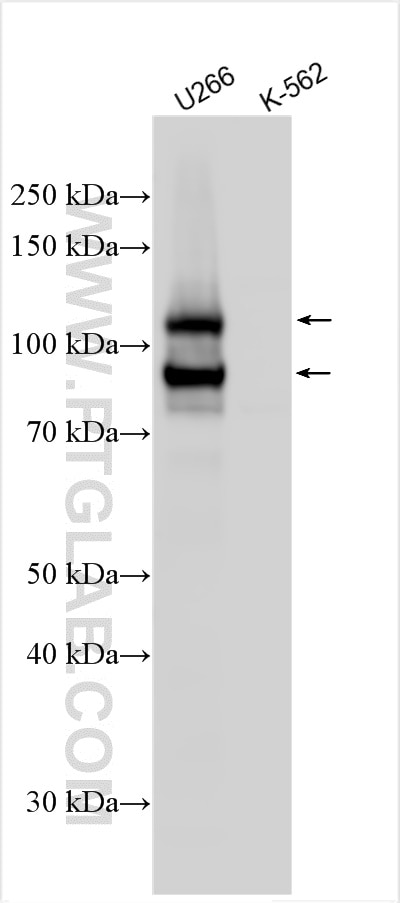Tested Applications
| Positive WB detected in | U266 cells |
Recommended dilution
| Application | Dilution |
|---|---|
| Western Blot (WB) | WB : 1:2000-1:16000 |
| It is recommended that this reagent should be titrated in each testing system to obtain optimal results. | |
| Sample-dependent, Check data in validation data gallery. | |
Product Information
31717-1-AP targets CD229/SLAMF3 in WB, ELISA applications and shows reactivity with human samples.
| Tested Reactivity | human |
| Host / Isotype | Rabbit / IgG |
| Class | Polyclonal |
| Type | Antibody |
| Immunogen | CD229/SLAMF3 fusion protein Ag34617 Predict reactive species |
| Full Name | lymphocyte antigen 9 |
| Observed Molecular Weight | 90 kDa, 110 kDa |
| GenBank Accession Number | BC121049 |
| Gene Symbol | LY9 |
| Gene ID (NCBI) | 4063 |
| RRID | AB_3670094 |
| Conjugate | Unconjugated |
| Form | Liquid |
| Purification Method | Antigen affinity purification |
| UNIPROT ID | Q9HBG7 |
| Storage Buffer | PBS with 0.02% sodium azide and 50% glycerol, pH 7.3. |
| Storage Conditions | Store at -20°C. Stable for one year after shipment. Aliquoting is unnecessary for -20oC storage. 20ul sizes contain 0.1% BSA. |
Background Information
Signaling lymphocytic activation molecule 3 (SLAMF3), also known as CD229 or Ly9, is a type I transmembrane glycoprotein that belongs to the SLAM family receptors (PMID: 10970093; 15905546). It is composed of an extracellular region, which consists of four Ig-like domains, a transmembrane region, and a cytoplasmic tail, which includes two immunoreceptor tyrosine-based signaling motifs (ITSMs) and other tyrosine residues that act as binding sites for the SH2 structural domains (PMID: 8537117; 11369645; 38626547). SLAMF3 is mainly expressed in immune cells, such as T, B, and natural killer cells, and it is involved in the fundamental activation and suppression of these immune cells, as well as the regulation of complex immune networks (PMID: 38626547).
Protocols
| Product Specific Protocols | |
|---|---|
| WB protocol for CD229/SLAMF3 antibody 31717-1-AP | Download protocol |
| Standard Protocols | |
|---|---|
| Click here to view our Standard Protocols |



